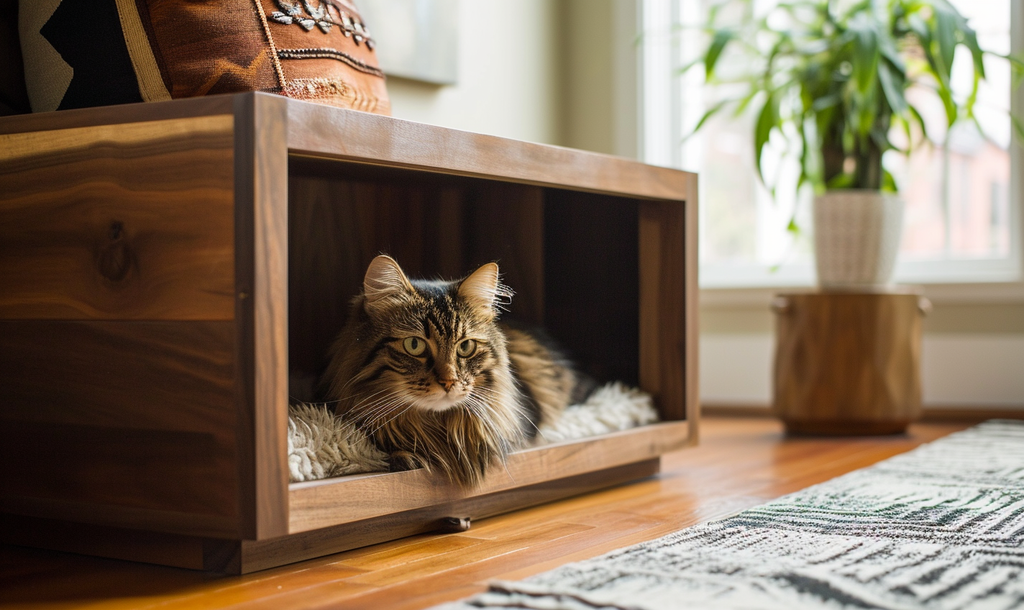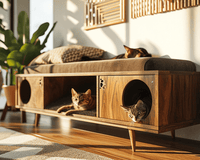Cats, beloved companions, often bring joy but their litter boxes might disrupt home aesthetics. Fortunately, a cat litter box enclosure seamlessly marries functionality and elegance, resolving this clash. Delve into this comprehensive step-by-step guide and learn how to fashion your personalized cat litter box enclosure, effortlessly harmonizing your home's style with your pet's needs.
Materials You'll Need:
- Sturdy Wood or Plywood: Selecting the right material for your cat litter box enclosure is crucial. Opting for sturdy, non-toxic wood or plywood ensures a durable structure that guarantees your cat's safety and comfort. Look for materials like birch, pine, or cedar, avoiding any treated wood that might contain harmful chemicals. This choice not only provides stability for the enclosure but also ensures it's a healthy environment for your feline friend.

- Basic Tools:To bring your cat litter box enclosure to life, gather the essential tools for this DIY project. You'll need a versatile saw for precise cuts, a reliable hammer for assembly, various nails and screws to secure the pieces, a measuring tape to ensure accurate dimensions, and a trusty pencil for marking your wood. These basic tools form the foundation of your crafting journey, enabling you to create a functional and stylish enclosure for your feline friend.

- Hinges, Latch, and Paint:Creating a functional and attractive cat litter box enclosure requires essential components that blend both form and function seamlessly. With sturdy wood or plywood as the foundation and the right tools at hand, such as saws, hammers, nails, screws, and additional elements like hinges, latches, and a suitable paint selection, you can construct a safe, personalized space for your cat that harmonizes with your home's aesthetic. Each material and tool plays a crucial role in ensuring the enclosure's durability, accessibility, and visual appeal, making the DIY process both rewarding and practical.

Steps to Build the Enclosure:
Step 1: Design and Measurements
When sketching the enclosure design, take into account your cat's size and the litter box dimensions. Each piece should be meticulously measured and planned to ensure a precise fit and comfortable space for your feline companion. This thoughtful approach guarantees a customized enclosure that perfectly suits your cat's needs and the available space in your home.

Step 2: Cutting and Sanding
Take your design blueprint and carefully cut the wood pieces, ensuring they align flawlessly. Once cut, devote time to smoothing the edges diligently with sandpaper; this not only guarantees safety for your cat but also adds a polished touch to the enclosure's construction. Remember, a well-sanded surface eliminates any roughness, providing a secure and comfortable environment for your feline friend.

Step 3: Assembling the Enclosure
Building the enclosure involves a systematic approach with nails and screws. Commence by assembling the base, sides, and back panel methodically, ensuring an open section remains for the door to seamlessly integrate into the structure. This step-by-step process lays the foundation for a functional and visually appealing cat litter box enclosure.

Step 4: Crafting the Door
Attaching hinges to the cut wood for the door is crucial for smooth movement and stability. Ensure they're properly aligned to allow easy opening and closing without any resistance. Installing a latch adds convenience for accessing the litter box during cleaning while keeping it secure. This step ensures your enclosure is functional, providing both you and your cat with hassle-free use.

Step 5: Finishing Touches
To attach hinges to the cut wood for the door, align them carefully on the designated spots ensuring a smooth swing. Secure them using screws, allowing the door to open and close seamlessly. Installing a latch adds convenience, ensuring easy access for cleaning while keeping the enclosure enclosed, maintaining a balance between accessibility and privacy for your cat.

Step 6: Placement and Usage
When placing the litter box inside the enclosure, consider finding a spot that strikes a balance between privacy and accessibility for your feline friend. Cats appreciate privacy when using their litter box, so choose a quieter corner or area away from heavy foot traffic. However, ensure it remains easily accessible to your cat. Guarantee that the entrance to the enclosure is spacious enough for your cat to comfortably enter and exit without feeling cramped or restricted, allowing them to use it effortlessly while feeling secure in their private space.

Additional Tips:
- Ventilation: Ensuring proper ventilation within your cat litter box enclosure is crucial for maintaining a fresh environment. Drill several small holes strategically along the upper sections of the enclosure to facilitate adequate air circulation. This prevents any potential buildup of odor and keeps the space comfortable for your feline friend. Balanced airflow also contributes to minimizing moisture accumulation, promoting a hygienic and pleasant environment for both you and your cat.

- Easy Cleaning:Ensuring easy cleaning is crucial for maintaining a hygienic cat litter box enclosure. Incorporating a removable top or door greatly facilitates this process. By implementing a design feature that allows swift access to the interior, you can effortlessly scoop, clean, and replace the litter as needed, promoting regular upkeep. This simple yet effective addition not only streamlines your cleaning routine but also ensures your feline friend's space remains fresh and inviting, contributing to a comfortable environment for both you and your cat.

- Personalization:Adding decorative elements to your cat litter box enclosure can transform it into a stylish addition to your home. Consider embellishing it with colorful decals that match your interior décor or placing a charming plant pot atop the enclosure, bringing a touch of nature to your space. These personalizations not only elevate the aesthetics but also integrate the enclosure seamlessly into your home environment, making it both functional and visually appealing.

Conclusion
Creating a cat litter box enclosure goes beyond cleanliness—it elevates your space while giving your pet a private haven. Let your creativity flourish as you tailor designs and materials to match your style and ensure your cat's ultimate comfort. This DIY project amalgamates functionality with aesthetics, adding a personalized touch to your home.

FAQs about Cat Litter Box Enclosures:
l Are these enclosures suitable for all litter box sizes?
Ensuring the enclosure size aligns with your cat's litter box dimensions is crucial. Ample space allows unrestricted movement, reducing any potential discomfort. This harmony fosters a stress-free environment, prioritizing your pet's comfort.
l Can I use different materials like plastic or metal for the enclosure?
Choose non-toxic woods like cedar or pine for safety. Opt for easy-to-clean finishes, ensuring a hygienic space for your cat.
l How do I keep the enclosure odor-free?
Maintaining a fresh environment for your feline friend is crucial. Regularly scoop the litter box, wipe down the enclosure, and opt for specialized odor-absorbing litter to keep unpleasant smells at bay and ensure a pleasant atmosphere for both you and your cat.
l Is it difficult to train my cat to use the enclosed litter box?
When introducing a new enclosed litter box, ensure the entry is easily accessible and comfortable for your feline friend. Providing a spacious and inviting entrance encourages quicker and smoother adaptation for your cat.
l Can I add a filter or ventilation system to the enclosure?
Yes, ensuring proper ventilation through filters or holes in the enclosure significantly improves air quality, minimizing any potential odors and keeping your cat's space fresh and inviting.













